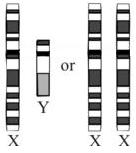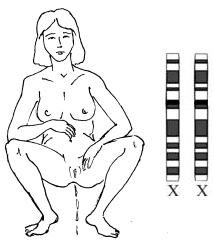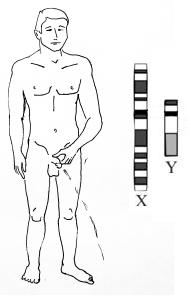Notes on and quotations from and about
Judith Butler

|
From Gender Trouble 1990 on genetics The introduction to Bodies That Matter: On the Discursive Limits of "Sex" (1993) |
"Sex and Gender in Simone de Beauvoir's Second Sex" (Judith Butler 1986)
"One is not born, but rather becomes, a woman" - Simone de Beauvoir's formulation distinguishes sex from gender and suggests that gender is an aspect of identity gradually acquired. The distinction between sex and gender has been crucial to the long-standing feminist effort to debunk the claim that anatomy is destiny; sex is understood to be the invariant, anatomically distinct, and factic aspects of the female body, whereas gender is the cultural meaning and form that that body acquires, the variable modes of that body's acculturation. With the distinction intact, it is no longer possible to attribute the values or social functions of women to biological necessity, and neither can we refer meaningfully to natural or unnatural gendered behaviour: all gender is, by definition, unnatural. Moreover, if the distinction is consistently applied, it becomes unclear whether being a given sex has any necessary consequence for becoming a given gender. The presumption of a causal or mimetic relation between sex and gender is undermined. If being a woman is one cultural interpretation of being female, and if that interpretation is in no way necessitated by being female, then it appears that the female body is the arbitrary locus of the gender 'woman', and there is no reason to preclude the possibility of that body becoming the locus of other constructions of gender. At its limit, then, the sex-gender distinction implies a radical heteronomy of natural bodies and constructed genders with the consequence that 'being' female and 'being' a woman are two very different sorts of being. This last insight, I would suggest, is the distinguished contribution of Simone de Beauvoir's formulation, "one is not born, but rather becomes, a woman."
According to the above framework, the term 'female' designates a fixed and self-identical set of natural corporeal facts (a presumption, by the way, which is seriously challenged by the continuum of chromosomal variations), and the term 'woman' designates a variety of modes through which those facts acquire cultural meaning.
The body politic
If the pure body cannot be found, if what can be found is the situated
body, a locus of cultural interpretations, then Simone de Beauvoir's
theory seems implicitly to ask whether sex was not gender all along.
Simone de Beauvoir herself does not follow through with the consequences
of this view of the body, but we can see the radicalization of her
view in the work of Monique Wittig and Michel Foucault: the former
self-consciously extends Simone de Beauvoir's doctrine in "One is Not
Born a Woman" [p.47]
The demarcation of anatomical difference does not precede
the cultural interpretation of that difference, but is itself an
interpretive
act laden with normative assumptions. That infants are divided
into sexes at birth, Wittig points out, serves the social ends of
reproduction, but they might just as well be differentiated on the basis
of ear lobe formation or, better still, not be differentiated on the basis
of anatomy at all.
In demarcating 'sex' as sex, we construct certain norms
of differentiation. And in the interest which fuels this demarcation
resides already a political program. In questioning the binary restrictions
on gender definition, Wittig and Foucault release gender from sex
in ways which Simone de Beauvoir probably did not imagine. And yet,
her view of the body as a "situation" certainly lays the groundwork for
such theories.
If 'existing' one's gender means that one is tacitly accepting or
reworking cultural norms governing the interpretation of one's body,
then gender can also be a place in which the binary system
restricting
gender is itself subverted. Through new formulations of gender, new
ways of amalgamating and subverting the oppositions of 'masculine'
and 'feminine', the established ways of polarizing genders becomes
increasingly
confused, and
binary opposition comes to oppose itself.
Through the purposeful embodiment of ambiguity binary oppositions
lose clarity and force, and 'masculine' and 'feminine' as descriptive
terms lose their usefulness. Inasmuch as gender ambiguity can take
many forms, gender itself thus promises to proliferate into a multiple
phenomenon for which new terms must be found.
Simone de Beauvoir does not suggest the possibility of other genders
besides 'man' and 'woman', yet her insistence that these are historical
constructs which must in every case be appropriated by individuals
suggests that a binary gender system has no ontological necessity.
One could respond that there are merely various ways of being a 'man' or a
'woman', but this view ascribes an ontology of substance to gender
which misses her point: 'man' and 'woman' are already ways of being,
modalities of corporeal existence, and only emerge as substantial entities
to a mystified perspective.
One might wonder as well whether
there is something about the dymorphic structure of human anatomy
that necessitates binary gender arrangements cross-culturally.
Anthropological
findings of third genders and multiple gender systems
suggest, however, that dymorphism itself becomes significant only
when cultural interests require, and that gender is more often based
upon kinship requirements than on anatomical exigencies.
Simone de Beauvoir's own existential framework may seem anthropologically
naive, relevant only to a postmodern few who essay to
trespass the boundaries of sanctioned sex. But the strength of her vision
lies less in its appeal to common sense than in the radical challenge she
delivers to the cultural status quo. The possibilities of gender
transformation
are not for that reason accessible only to those initiated into the
more abstruse regions of existential Hegelianism, but reside in the daily
rituals of corporeal life. Her conceptualization of the body as a nexus of
interpretations, as both "perspective" and "situation," reveals gender
as a scene of culturally sedimented meanings and a modality of
inventiveness.
To become a gender means both to submit to a cultural
situation and to create one, and this view of gender as a dialectic of
recovery and invention grants the possibility of autonomy within corporeal
life that has few if any parallels in gender theory.
[p.49]
...
Although writing in very different discursive contexts, Wittig
and Foucault both challenge the notion of natural sex and expose the
political uses of biological discriminations in establishing a compulsory
binary gender system. For both theorists, the very
discrimination of
'sex' takes place within a cultural context which requires that 'sex'
remain dyadic. [double - twofold]
...
The body becomes a choice, a mode of
enacting and reenacting received gender norms which surface as so
many styles of the flesh.
The incorporation of the cultural world is a task performed incessantly
and actively, a project enacted so easily and constantly it seems a
natural fact. Revealing the natural body as already clothed, and nature's
surface as cultural invention, Simone de Beauvoir gives us a potentially
radical understanding of gender. Her vision of the body as a field of
cultural possibilities makes some of the work of refashioning culture as
mundane as our bodily selves.
|
Genetically, biologists argue, we have our
biological sex (gender)
determined by the combination of X (female determining factor) and Y (male
determining factor)
chromosomes in our cells. Females have two X
chromosomes (XX) - Males have one of each (XY).
In the extracts below, Judith Butler discusses the interrelationship between a biologically determined view of sex (gender) and other views. She uses examples of people whose external genitalia do not match their chromsomes in the way decribed above. She does this because she argues that looking at the way we think about such people helps us to understand more about how we understand sex generally. She says
"The point here is not to seek recourse to the exceptions, the bizarre, in order merely to relativize the claims made in behalf of normal sexual life. ... it is the exception, the strange, that gives us the clue to how the mundane and taken-for-granted world of sexual meanings is constituted." |
Does sex have a history? Does each sex have a different history, or histories? Is there a history of how the duality of sex was established, a genealogy that might expose the binary options as a variable construction? Are the ostensibly natural facts of sex discursively produced by various scientific discourses in the service of other political and social interests?
If the immutable character of sex is contested, perhaps this construct called "sex" is as culturally constructed as gender; indeed, perhaps it was always already gender, with the consequence that the distinction between sex and gender turns out to be no distinction at all.
It would make no sense, then, to define gender as the cultural interpretation of sex, if sex itself is a gendered category. Gender ought not to be conceived merely as the cultural inscription of meaning on a pregiven sex (a juridical conception); gender must also designate the very apparatus of production whereby the sexes themselves are established.
Notes on and quotes from Gender Trouble: Feminism and the Subversion of
Identity (1990) by Judith Butler
From "Concluding Unscientific Postscript"
A contemporary example of this quest for
identity can be found in recent developments in cell biology...
the recent controversy
over the master gene that researchers at MIT in late
1987 claim
to have discovered as the secret and certain determinant of sex.

|
With
the use of highly sophisticated technological means, the master gene,
which constitutes a specific DNA sequence on the Y chromosome, was
discovered by Dr
David Page and his colleagues and named "TDF" or
testis-determining factor.
See
interview with Jenny
Graves which explains the experiment. [First
archived 29.11.2005]
|
In the publication of his findings in Cell (No. 51), Dr. Page claimed to have discovered "the binary switch upon which hinges all sexually dimorphic characteristics."
Let us then consider the claims of this discovery and see why the unsettling questions regarding the decidability of sex continue to be asked.
According to Page's article, "The Sex-Determining Region of the Human Y Chromosome Encodes a Finger Protein", samples of DNA were taken from a highly unusual group of people, some of whom had XX chromosomes, but had been medically designated as males, and some of whom had XY chromosomal constitution, but had been medically designated as female.
He does not tell us exactly on what basis they had been designated contrary to the chromosomal findings, but we are left to presume that obvious primary and secondary characteristics suggested that those were, indeed, the appropriate designations.
|
Page and his coworkers made the following hypothesis: There must be some stretch of DNA, which cannot be seen under the usual microscopic conditions, that determines the male sex, and this stretch of DNA must have been moved somehow from the Y chromosome, its usual location, to some other chromosome, where one would not expect to find it. Only if we could presume (a) this undetectable DNA sequence and (b) prove its translocatability, could we understand why it is that an XX male had no detectable Y chromosome, but was, in fact, still male. Similarly, we could explain the curious presence of the Y chromosome on females precisely because that stretch of DNA had somehow been misplaced.
|
Was Jesus an XX-male?: Debate on Catholic
Answers Forum starting 2.1.2010
When females are born with XY chromosomes and males are born with XX then what determines their sex? Yahoo Answers 2010 |
Although the pool that Page and his researchers used to come up with this finding was limited, the speculation on which they base their research, in part, is that a good ten percent of the population has chromosomal variations that do not fit neatly into the XX-female and XY-male set of categories. Hence, the discovery of the "mastergene" is considered to be a more certain basis for understanding sex determination and, hence, sex-difference, than previous chromosomal criteria could provide.
Unfortunately for Page, there was one persistent problem that haunted the claims made on behalf of the discovery of the DNA sequence. Exactly the same stretch of DNA said to determine maleness was, in fact, found to be present on the X chromosomes of females. Page first responded to this curious discovery by claiming that perhaps it was not the presence of the gene sequence in males versus its absence in females that was determining, but that it was active in males and passive in females (Aristotle lives!). But this suggestion remains hypothetical and, according to Anne Fausto-Sterling, Page and his coworkers failed to mention in that Cell article that the individuals from whom the gene samples were taken were far from unambiguous in their anatomical and reproductive constitutions. I quote from her article, "Life in the XY Corral":
"the four XX males whom they studied were all sterile (no sperm production), had small testes which totally lacked germ cells, i.e., precursor cells for sperms. They also had high hormone levels and low testosterone levels. Presumably they were classified as males because of their external genitalia and the presence of testes. . . . Similarly . . . both of the XY females' external genitalia were normal, [but] their ovaries lacked germ cells."
Clearly these are cases in which the component parts of sex do not add up to the recognizable coherence or unity that is usually designated by the category of sex. This incoherence troubles Page's argument as well, for it is unclear why we should agree at the outset that these are XX-males and XY-females, when it is precisely the designation of male and female that is under question and that is implicitly already decided by the recourse to external genitalia. Indeed, if external genitalia were sufficient as a criterion by which to determine or assign sex, then the experimental research into the master gene would hardly be necessary at all.
But consider a different kind of problem with the way in which that particular hypothesis is formulated, tested, and validated. Notice that Page and his coworkers conflate sex-determination with maledetermination, and with testis-determination. Geneticists Eva Eicher and Linda L.Washburn in the Annual Review of Genetics suggest that ovary-determination is never considered in the literature on sexdetermination and that femaleness is always conceptualized in terms of the absence of the male-determining factor or of the passive presence of that factor. As absent or passive, it is definitionally disqualified as an object of study. Eicher and Washburn suggest, however, that it is active and that a cultural prejudice, indeed, a set of gendered assumptions about sex, and about what might make such an inquiry valuable, skew and limit the research into sex-determination. Fausto-Sterling quotes Eicher and Washburn:
"Some investigators have overemphasized the hypothesis that the Y chromosome is involved in testis-determination by presenting the induction of testicular tissue as an active, (gene-directed, dominant) event while presenting the induction of ovarian tissue as a passive (automatic) event. Certainly, the induction of ovarian tissue is as much an active, genetically directed developmental process as the induction of testicular tissue, or for that matter, the induction of any cellular differentiation process. Almost nothing has been written about genes involved in the induction of ovarian tissue from the undifferentiated gonad."
In related fashion, the entire field of embryology has come under criticism for its focus on the central role of the nucleus in cell differentiation. Feminist critics of the field of molecular cell biology have argued against its nucleocentric assumptions. As opposed to a research orientation that seeks to establish the nucleus of a fully differentiated cell as the master or director of the development of a complete and well-formed new organism, a research program is suggested that would reconceive the nucleus as something which gains its meaning and control only within its cellular context. According to Fausto- Sterling,
"the question to ask is not how a cell nucleus changes during differentiation, but, rather, how the dynamic nuclear-cytoplasmic interactions alter during differentation"
The structure of Page's inquiry fits squarely within the general trends of molecular cell biology. The framework suggests a refusal from the outset to consider that these individuals implicitly challenge the descriptive force of the available categories of sex; the question he pursues is that of how the "binary switch" gets started, not whether the description of bodies in terms of binary sex is adequate to the task at hand. Moreover, the concentration on the "master gene" suggests that femaleness ought to be understood as the presence or absence of maleness or, at best, the presence of a passivity that, in men, would invariably be active. This claim is, of course, made within the research context in which active ovarian contributions to sex differentiation have never been strongly considered. The conclusion here is not that valid and demonstrable claims cannot be made about sex determination, but rather that cultural assumptions regarding the relative status of men and women and the binary relation of gender itself frame and focus the research into sex-determination. The task of distinguishing sex from gender becomes all the more difficult once we understand that gendered meanings frame the hypothesis and the reasoning of those biomedical inquiries that seek to establish "sex" for us as it is prior to the cultural meanings that it acquires. Indeed, the task is even more complicated when we realize that the language of biology participates in other kinds of languages and reproduces that cultural sedimentation in the objects it purports to discover and neutrally describe.
Is it not a purely cultural convention to which Page and others refer when they decide that an anatomically ambiguous XX individual is male, a convention that takes genitalia to be the definitive "sign" of sex?
One might argue that the discontinuities in these instances cannot be resolved through recourse to a single determinant and that sex, as a category that comprises a variety of elements, functions, and chromosomal and hormonal dimensions, no longer operates within the binary framework that we take for granted. The point here is not to seek recourse to the exceptions, the bizarre, in order merely to relativize the claims made in behalf of normal sexual life. As Freud suggests in Three Essays on the Theory of Sexuality, however, it is the exception, the strange, that gives us the clue to how the mundane and taken-for-granted world of sexual meanings is constituted.
Only from a self-consciously denaturalized position can we see how the appearance of naturalness is itself constituted. The presuppositions that we make about sexed bodies, about them being one or the other, about the meanings that are said to inhere in them or to follow from being sexed in such a way are suddenly and significantly upset by those examples that fail to comply with the categories that naturalize and stabilize that field of bodies for us within the terms of cultural conventions. Hence, the strange, the incoherent, that which falls "outside," gives us a way of understanding the taken- forgranted world of sexual categorization as a constructed one, indeed, as one that might well be constructed differently.
Although we may not immediately agree with the analysis that Foucault supplies - namely, that the category of sex is constructed in the service of a system of regulatory and reproductive sexuality - it is interesting to note that Page designates the external genitalia, those anatomical parts essential to the symbolization of reproductive sexuality, as the unambiguous and a priori determinants of sex assignment.
One might well argue that Page's inquiry is beset by two discourses that, in this instance, conflict: the cultural discourse that takes external genitalia to be the sure signs of sex, and does that in the service of reproductive interests, and the discourse that seeks to establish the male principle as active and monocausal, if not autogenetic.
The desire to determine sex once and for all, and to determine it as one sex rather than the other, thus seems to issue from the social organization of sexual reproduction through the construction of the clear and unequivocal identities and positions of sexed bodies with respect to each other. Because within the framework of reproductive sexuality the male body is usually figured as the active agent, the problem with Page's inquiry is, in a sense, to reconcile the discourse of reproduction with the discourse of masculine activity, two discourses that usually work together culturally, but in this instance have come apart. Interesting, then, is Page's willingness to settle on the active DNA sequence as the last word, in effect giving the principle of masculine activity priority over the discourse of reproduction.
Notes on and quotes from the introduction to Bodies That Matter: On the Discursive Limits of "Sex" (1993) by Judith Butler
"I pronounce you different bodies"

says society |
Language is performative if the saying of something does the deed. If the
authorised person says "I pronounce you man and wife" in the right
circumstances, the two people it is said to become man and wife
Judith Butler asks:
"Is there a way to link the question of the materiality of the body to the performativity of gender? And how does the category of "sex" figure within such a relationship?" Performativity is a pronouncement of what we will perform. Society does the pronouncing |
|
But what does Butler mean by sex?
She continues: "Consider first that sexual difference is often invoked as an issue of material differences."
[Right: How do you know the sexual difference?
"Sexual difference, however, is never simply a function of material differences which are not in some way both marked and formed by discursive practices". That means that the way our culture talks about our bodies makes a difference to our bodies. |

|
"Further, to claim that sexual differences are indissociable from discursive demarcations is not the same as claiming that discourse causes sexual difference."

|

|
Butler "sexual difference ... is never simply a function of material differences" [1993]
"The category of "sex" is, from the start, normative; it is what Foucault
has called a
"regulatory ideal". [Where?]. In this sense, then, "sex" not only functions
as a
norm,
but is part of a regulatory practice that produces the bodies it governs,
that
is, whose regulatory force is made clear as a kind of productive power, the
power to produce - demarcate, circulate, differentiate - the bodies it
controls.
Thus, "sex" is a regulatory ideal whose materialization is compelled, and
this materialization takes place (or fails to take place) through certain
highly regulated practices. In other words, "sex" is an ideal construct
which is forcibly materialized through time. It is not a simple fact or
static condition of a body, but a process whereby regulatory norms
materialize "sex" and achieve this materialization through a forcible
reiteration of those norms. That this reiteration is necessary is a sign
that materialization is never quite complete, that bodies never quite
comply with the norms by which their materialization is impelled. Indeed,
it is the instabilities, the possibilities for rematerialization, opened up
by this process that mark one domain in which the force of the regulatory
law can be turned against itself to spawn rearticulations that call into
question the hegemonic force of that very regulatory law.
But how, then, does the notion of gender
performativity
relate to this
conception of materialization? In the first instance, performativity must
be understood not as a singular or deliberate "act," but, rather, as the
reiterative and citational practice by which discourse produces the effects
that it names. What will, I hope, become clear in what follows is that the
regulatory norms of "sex" work in a performative fashion to constitute the
materiality of bodies and, more specifically, to materialize the body's
sex, to materialize sexual difference in the service of the consolidation
of the heterosexual imperative.
In this sense, what constitutes the fixity of the body, its contours, its
movements, will be fully material, but materiality will be rethought as the
effect of power, as power's most productive effect. And there will be no
way to understand "gender" as a cultural construct which is imposed upon
the surface of matter, understood either as "the body" or its given sex.
Rather, once "sex" itself is understood in its normativity, the materiality
of the body will not be thinkable apart from the materialization of that
regulatory norm. "Sex" is, thus, not simply what one has, or a static
description of what one is: it will be one of the norms by which the "one"
becomes viable at all, that which qualifies a body for life within the
domain of cultural intelligibility.
At stake in such a reformulation of the materiality of bodies will be the
following:
(1) the recasting of the matter of bodies as the effect of a dynamic of
power, such that the matter of bodies will be indissociable from the
regulatory norms that govern their materialization and the signification of
those material effects;
(2) the understanding of performativity not as the act by which a subject
brings into being what she/he names, but, rather, as that reiterative power
of discourse to produce the phenomena that it regulates and constrains;
(3) the construal of "sex" no longer as a bodily given on which the
construct of gender is artificially imposed, but as a cultural norm which
governs the materialization of bodies;
(4) a rethinking of the process by which a bodily norm is assumed,
appropriated, taken on as not, strictly speaking, undergone by a subject,
but rather that the subject, the speaking "I," if formed by virtue of
having gone through such a process of assuming a sex; and
(5) a linking of this process of "assuming" a sex with the question of
identification, and with the discursive means by which the heterosexual
imperative enables certain sexed identifications and forecloses and/or
disavows other identifications. This exclusionary matrix by which subjects
are formed thus requires the simultaneous production of a domain of abject
beings, those who are not yet "subjects," but who form the constitutive
outside to the domain of the subject. The abject designates here precisely
those "unlivable" and "uninhabitable" zones of social life which are
nevertheless densely populated by those who do not enjoy the status of the
subject, but whose living under the sign of the "unlivable" is required to
circumscribe the domain of the subject. This zone of uninhabilitability
will constitute the defining limit of the subject's domain; it will
constitute that site of dreaded identification against which - and by
virtue of which - the domain of the subject will circumscribe its own claim
to autonomy and to life. In this sense, then, the subject is constituted
through the force of exclusion and abjection, one which produces a
constitutive outside to the subjected, an abjected outside, which is, after
all, "inside" the subject as its own founding repudiation."
Somebody might well say: isn't it the case that certain bodies go to the
gynaecologist for certain kinds of examination and certain bodies do not?
And I would obviously affirm that. But the real question here is: to what
extent does a body get defined by its capacity for pregnancy?
Why is it
pregnancy by which that body gets defined? One might say it's
because
somebody is of a given sex that they go to the gynaecologist to get an
examination that establishes the possibility of pregnancy, or one might say
that going to the gynaecologist is the very production of "sex" - but it is
still the question of pregnancy that is centering that whole institutional
practice here.
Now, it seems to me that, although women's bodies generally speaking are
understood as capable of impregnation, the fact of the matter is that there
are female infants and children who cannot be impregnated, there are older
women who cannot be impregnated, there are women of all ages who cannot be
impregnated, and even if they could ideally, that is not necessarily the
salient feature of their bodies or even of their being women. What the
question does is try to make the problematic of reproduction central to the
sexing of the body. But I am not sure that is, or ought to be, what is
absolutely salient or primary in the sexing of the body. If it is, I think
it's the imposition of a norm, not a neutral description of biological
constraints.
I do not deny certain kinds of biological differences. But I always ask
under what conditions, under what discursive and institutional conditions,
do certain biological differences - and they're not necessary ones, given
the anomalous state of bodies in the world - become the salient
characteristics of sex. In that sense I'm still in sympathy with the
critique of "sex" as a political category offered by Monique Wittig. I
still very much believe in the critique of the category of sex and the ways
in which it's been constrained by a tacit institution of compulsory
reproduction.
It's a practical problem. If you are in your late twenties or your early
thirties and you can't get pregnant for biological reasons, or maybe you
don't want to, for social reasons - whatever it is - you are struggling
with a norm that is regulating your sex. It takes a pretty vigorous (and
politically informed) community around you to alleviate the possible sense
of failure, or loss, or impoverishment, or inadequacy - a collective
struggle to rethink a dominant norm. Why shouldn't it be that a woman who
wants to have some part in child-rearing, but doesn't want to have a part
in child-bearing, or who wants to have nothing to do with either, can
inhabit her gender without an implicit sense of failure or inadequacy? When
people ask the question "Aren't these biological differences?", they're not
really asking a question about the materiality of the body. They're
actually asking whether or not the social institution of reproduction is
the most salient one for thinking about gender. In that sense, there is a
discursive enforcement of a norm.
That I can write in an autobiographical mode does not, I think, relocate this subject that I am, but perhaps it gives the reader a sense of solace that there is someone here (I will suspend for the moment the problem that this someone is given in language).
The Current State of Sociological Research into Genetics and Identity from Christine Hauskeller, Steve Sturdy and Richard Tutton's "Genetics and the Sociology of Identity" in Sociology October 2013
In confronting genetic determinism and essentialism, sociologists have faced the need to articulate a social-scientific language for speaking about the effects of genetic knowledge in identity formation that does not carry over the determinist or essentialist notions of the scientific discourse. In so doing, they have reprised long-running debates about social identity and status marking.
With genetics, internal biological determinants of identity take on the solidity that earlier social theorists, including Karl Marx, Max Weber, Karl Mannheim and Claude Lévi-Strauss assigned mainly to external material conditions of social life. While these theorists insisted that identities are socially produced, they nonetheless tended to see them as relatively stable and determinate, as firmly engraved into a person's or a social group's ways of being. In this view, class, culture, gender and professional identities were seen as integral to, and constitutive of, the individual as an embodied personality.
Other commentators, meanwhile, motivated by a more immediate desire to change societal structures and alleviate the suffering and injustice they produce, formulated more critical accounts of the constitutive force or coercion of societal structures on the individual being. Feminist authors, from Olympe de Gouges ... and Harriet Taylor ... to Simone de Beauvoir's analysis of the social construction of The Second Sex ..., have been influential in this context.
Other major contributions to a general critique of the way that social forces necessitate and form personal identities include The Authoritarian Personality by Theodor W. Adorno et al. (1950) and Erving Goffman's (1963) work on stigma as the burden of the marginalised.
As a result of such analyses, and contributing to a better understanding of the social mechanisms of inclusion and exclusion, social scientists have developed a range of critical methods to explore what it means to belong to and to 'be' a certain sex or gender, ethnicity, profession, class or family and the societal institutions that co-create these identities.
The tension between detreminism and voluntarism in sociological accounts of identity formation can also be traced in the rather different ways in which sociologists have responded to the challenge of genetic determinism precipitated by the Human Genome Project. Some of the earliest responses can be found in the writings of Judith Butler and Anthony Giddens. Both acknowledge that the complexity of individual experience and desires does not fit with stereotypical identities. Individuals are forced to match imposed (or seemingly imposed) societal expectations.
But Butler and Giddens differ in the way they think about how the materiality of embodiment is implicated in identity formation.
In Gender Trouble Butler (1990) reflects on the dualistic relationship between a material embodiment of sex in chromosomes and genitals on the one hand and the socially construed formation of gender identities on the other, struggling to find a correspondence between what she perceives as bodily facts and her Nietzschean ideal of multiple and changing gender identities. For Butler, there is nothing 'natural' about bodies. Rather, the individual and her or his body are alike shaped in relation to the unavoidable pressure to develop and to portray identities that can never be fully owned by the individuals who simultaneously are and present them.
By contrast, Giddens dismisses the question of the naturalness of bodies, which he views instead as in effect material substrates or instruments through which identity may be performed voluntaristically. In Modernity and Self-Identity (1991) he goes so far as to envisage selected modifications of a person's genome as a novel and empowering means of performing identity, and hence of becoming who one wants to be. He expresses the expectation that an increase in the technical ability to modify bodies and genomes will widen the scope of identities that can be adopted.
Butler and Giddens see performance of identity as what makes identities real, but take a different view on the role of embodiment and agency, which relates to a different ethics in relation to identity formation. For Butler, the gap between the inner self and the social identities embodied by an individual is an inevitable source of unhappiness or melancholy, motivating the desire for social change, which is a slow and embodied process. On this account, Butler positions the reflexive subject with an ethics of vulnerability and responsiveness against identity practices that she interprets as a form of violence (Butler, J. 2005).
From a more rationalist background, Giddens looks to technologies of body modification to enhance the personal freedom to choose who one wants to be. He stresses that performances of identity and their recognition by others and by institutions are at the heart of what an identity is, and he emphasises the choice aspect of identities.
Yet both Butler and Giddens view identities as established and verified in and through social interactions. Identities are the product of power relations, and individual power lies in adopting and living those relations.
|
Reference to John H. Bancroft (2009)
Human Sexuality and its Problems [Third edition]
"continues to address the neurophysiological, psychological and socio-cultural aspects of human sexuality and how they interact". |
|
Reference to Fausto-Sterling, 2000 Sexing the Body: Gender Politics and
the
Construction of Sexuality
But the International Olympic Committee (IOC) had anticipated the possibility that some competitors would forget their certificates of femininity. Patino had only to report to the ''femininity control head office,'' scrape some cells off the side of her cheek, and all would be in order - or so she thought. A few hours after the cheek scraping she got a call. Something was wrong. She went for a second examination, but the doctors were mum. Then, as she rode to the Olympic stadium to start her first race, track officials broke the news: she had failed the sex test. She may have looked like a woman, had a woman's strength, and never had reason to suspect that she wasn't a woman, but the examinations revealed that Patino's cells sported a Y chromosome, and that her labia hid testes within. Furthermore, she had neither ovaries nor a uterus. According to the IOC's definition, Patino was not a woman. She was barred from competing on Spain's Olympic team |
Likewise, research in epigenetics is throwing new light on the responsiveness of the living genome to changes in the environment, as scientists increasingly recognise that genomes and bodies may themselves be shaped by a wide range of everyday experiences and long- term practices, and not only by invasively radical changes such as genetic engineering.
A range of identity-relevant areas of social practice, including the food we eat and the exercise we do or do not take, contribute to making us who we are physically as well as socially. While there are limits to how far persons can change their bodies through such practices, lifestyle affects what genes do and thus has an impact on many aspects of the organism, including appearance (aging skin and sun exposure, for example), metabolism (famine in perinatal development has been linked to disturbed insulin production 60 years later) and health (development of cancers).
Research into epigenetics thus suggests that identities, including bodily markers of identity, are formed not only by how individuals and others classify, think and judge, but also through the way in which we live our lives. and bodies are not just given but socially constructed.
Such research opens up a new reflexive space for reconsidering the mutual interactions between genetics and identity, and between the genomic activities that occur in the body and the social practices of identity in which bodies are situated and constituted.
Yet, while considerations arising through engagement with cutting-edge
genomic
research may help to frame future social research and theorising, it has to
be acknowledged that they do not, on the whole, reflect either common
understandings of genetics
or the way in which genetic technologies are currently used in social
institutions. The
common understanding of genetics, and the social practices in which it is
employed,
continue to be largely based on the assumption that genes cause or are
stable indicators
for individual characteristics.
 Top of
Page
Top of
Page
Andrew Roberts likes to hear from users:
To contact him, please
use the Communication
Form




